Howler monkeys are one of the most iconic species that inhabit the tropical forests of Central and South America. These primates are known for their distinctive howling calls, which they use to communicate with other members of their troop and establish territory boundaries.
However, like all living creatures, howler monkeys face a range of threats from predators in their natural habitat. Predation is an important ecological force that shapes animal populations, and understanding the predator-prey dynamics can provide valuable insights into ecosystem functioning.
The study of howler monkey predation has been a topic of interest among researchers for decades, as these primates play a key role in maintaining forest health and biodiversity. In this article, we will explore some common predators of howler monkeys and examine the ways in which these animals have evolved to cope with predation pressure.
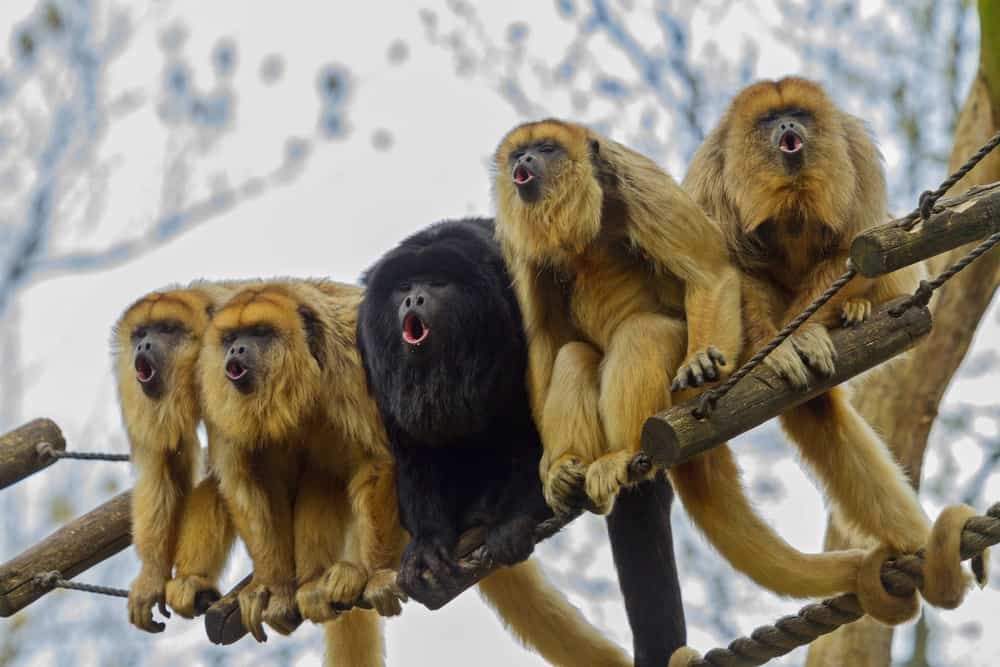
The Importance Of Predation In Ecosystems
Exploring impacts of predation in ecosystems is crucial to understanding how ecological systems work.
Predators play a significant role in balancing ecosystems by controlling the population size and distribution of prey species, preventing overgrazing or over-browsing which can lead to habitat degradation and loss of biodiversity.
In addition, predators also shape the behavior and life history traits of their prey, leading to evolutionary adaptations that enhance survival.
Predation can have both direct and indirect effects on ecosystem dynamics.
Direct effects include reducing herbivore populations, while indirect effects are those occurring through changes in plant growth patterns due to reduced grazing pressure.
The removal of top predators from an ecosystem may result in cascading effects throughout the food web, altering community structure and ecosystem functioning.
Therefore, understanding the importance of predation is critical for maintaining healthy ecosystems that provide essential services such as clean air, water, and climate regulation without compromising other aspects such as agriculture or forestry production.
Red Leaf Monkeys’ Predators Revealed: Unmasking the Threats
Understanding Howler Monkey Behavior
Predation plays a crucial role in shaping the dynamics of ecosystems. By consuming prey, predators limit the population size of herbivores and prevent them from overgrazing vegetation. Additionally, predation can create a cascade effect on lower trophic levels as it alters the abundance and distribution of species within an ecosystem. One such example is the influence of predators on howler monkeys.
Howler monkeys are primates that inhabit Central and South America’s forests and have few natural predators due to their large size and loud vocalizations. However, some animals pose a threat to these arboreal creatures, including jaguars, ocelots, harpy eagles, and boa constrictors. As a response to these threats, howlers exhibit various behavioral patterns to avoid or deter potential predators, such as staying high up in trees or traveling with other group members for protection.
Understanding how these social dynamics work among howlers could reveal more about their adaptations to survive in predator-rich environments. Furthermore, research has shown that howler monkeys’ behavior changes depending on factors like food availability or temperature fluctuations. For instance, during times of low food resources when they need to conserve energy expenditure for survival purposes; they tend to become less active than usual by spending most of their time resting instead of searching for food actively.
These shifts in behavior highlight the importance of understanding not only predator-prey interactions but also animal responses to environmental pressures for effective conservation management practices without disrupting ecological balance.
Common Predators Of Howler Monkeys
The rainforest environment can be a dangerous place for howler monkeys, as they have many natural predators. Predators of howler monkeys include jaguars, pumas, ocelots, and large birds of prey such as harpy eagles. These animals are skilled hunters that rely on their stealth and agility to capture their prey.
Jaguars are considered the primary predator of howler monkeys due to their strength and speed. They often ambush their prey from above or behind, using a powerful bite to dispatch them quickly.
Pumas and ocelots also pose a threat, with pumas being known to stalk their prey before attacking while ocelots use their sharp claws to climb trees in pursuit of the primates.
Harpy eagles are one of the largest birds of prey in the world and they are capable of capturing even adult howler monkeys weighing up to 10 kg (22 lb) by swooping down at high speeds from the treetops.
While these predators may seem daunting, it is important to remember that they play an essential role in maintaining balance within the ecosystem.
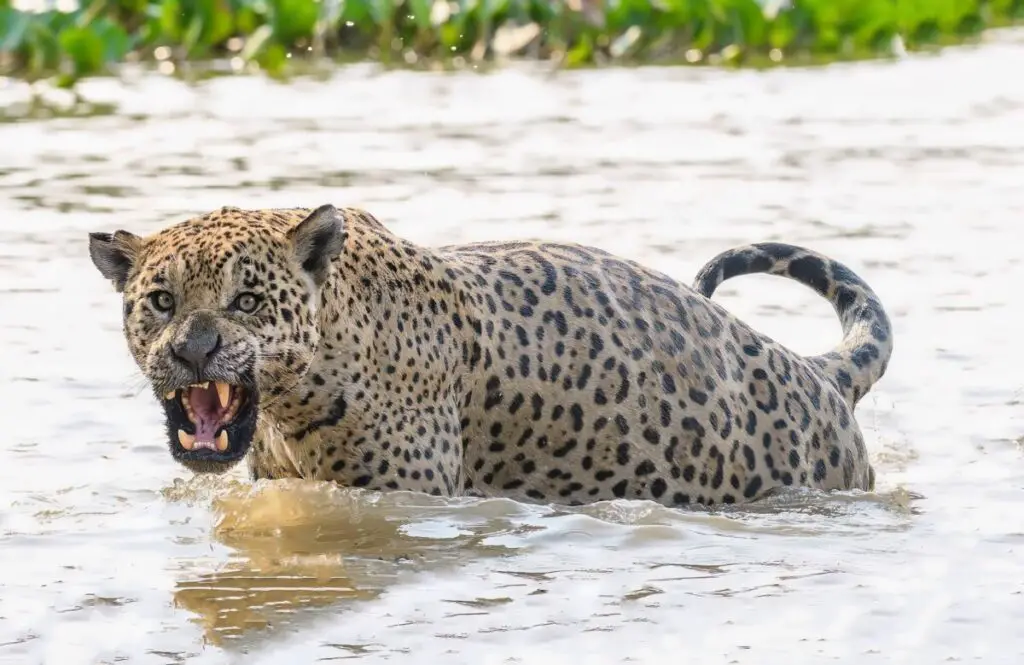
Jaguars
The piercing roar of a jaguar echoes through the rainforest, striking fear into the hearts of all creatures. As an apex predator, jaguars play a crucial role in maintaining balance within the ecosystem. They are skilled hunters with powerful jaws capable of crushing bones and sharp claws that can tear flesh apart.
Unfortunately, due to human activity such as deforestation and hunting for their skins, jaguars have become threatened in many areas.
Jaguars and other predators like them are essential components of rainforest dynamics. Their presence helps regulate populations of prey species such as howler monkeys, reducing overgrazing pressure on vegetation and preventing ecological imbalances.
However, conservation strategies must be implemented to ensure these majestic animals continue to thrive in their natural habitats. This includes protecting large tracts of land where they can roam freely without interference from humans while also addressing illegal poaching and trafficking of jaguar parts. Ultimately, preserving this top predator is critical not just for its own survival but for that of countless other species living within the intricate web of life found in the world’s rainforests.
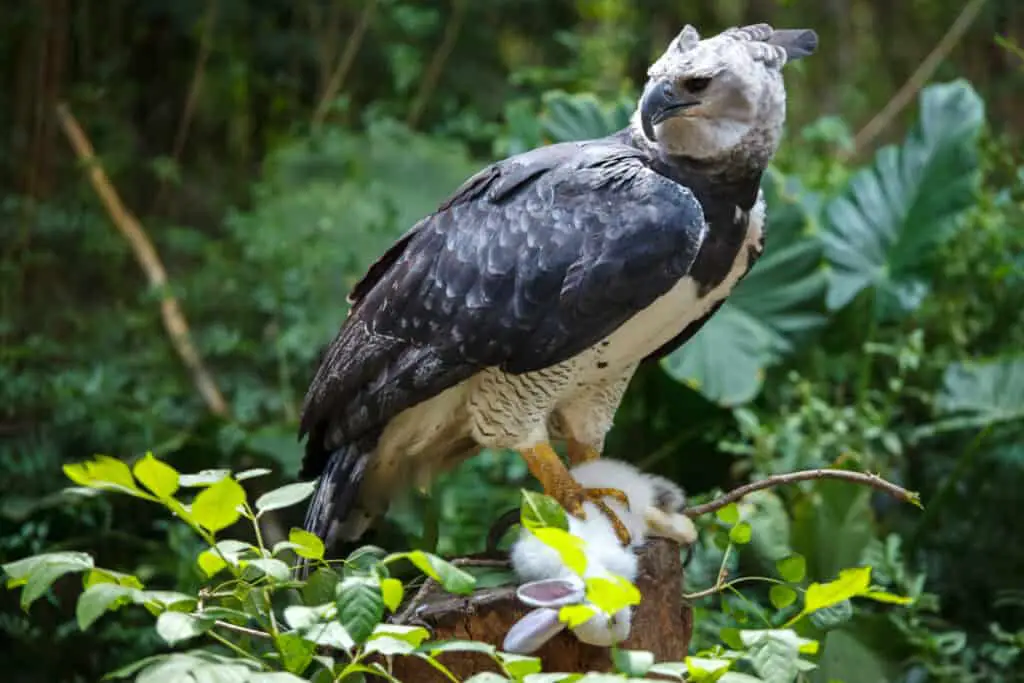
Birds Of Prey
Jaguars are the apex predator of the rainforest, but they are not the only threat to howler monkeys. Birds of prey also pose a significant danger to these primates.
While jaguars hunt on the ground, birds of prey use their aerial advantage to swoop down and capture their prey. There are several types of birds of prey that feed on howler monkeys, including harpy eagles, crested eagles, and black hawks.
These birds use various hunting techniques such as perching high up in trees or flying low over the forest canopy to spot potential targets. Once a monkey is spotted, the bird will dive at incredible speeds towards its prey, using its sharp talons to snatch it from branches or even pluck it mid-air.
Howler monkeys have been known to vocalize loudly when threatened by predators like birds of prey. However, this warning call can sometimes be ineffective against aerial hunters since they attack from above without giving any audible cues.
In conclusion, while jaguars remain an important predator for howler monkeys in the rainforest ecosystem, we must also acknowledge the impact that birds of prey have on these primates’ populations. Understanding their hunting techniques and behaviors is crucial for conservation efforts aimed at preserving these unique creatures’ habitats and reducing human-induced threats like deforestation and habitat destruction.
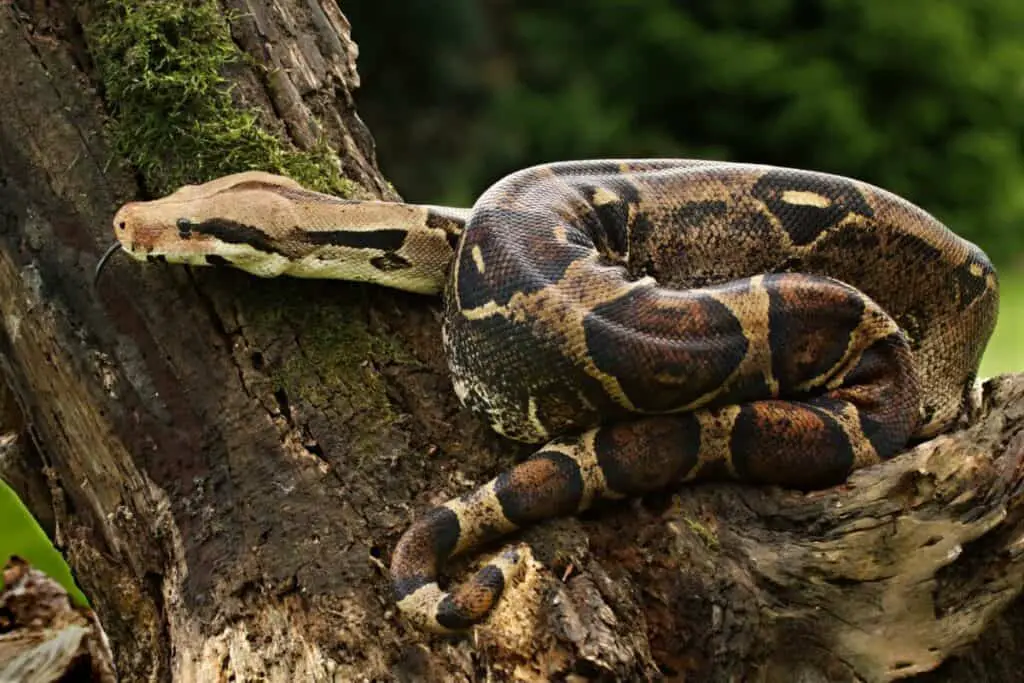
Boa Constrictors
Boa constrictors are formidable predators of howler monkeys in their shared habitats. These large constrictor snakes are known for their ability to overpower and suffocate their prey. While their diet mainly consists of small to medium-sized mammals and birds, they have been observed capturing and subduing howler monkeys on occasion.
When a boa constrictor detects a howler monkey, it relies on its keen sense of smell and heat-sensing pits to locate the prey. Boas are ambush predators, often waiting patiently for the right moment to strike. Once in striking range, they lunge at the monkey, using their sharp teeth to seize it. They then rapidly coil their muscular bodies around the unfortunate victim, constricting it with immense force.
As the boa constrictor tightens its grip, it restricts the howler monkey’s breathing and blood flow, leading to eventual asphyxiation and death. Boas are capable of exerting tremendous pressure with their coils, effectively immobilizing the prey and rendering it defenseless. Their flexible jaws allow them to consume prey larger in diameter than their own heads, enabling them to consume an entire howler monkey after a successful hunt.
Despite their potential threat, it’s important to note that predation by boa constrictors on howler monkeys is not a common occurrence. Howler monkeys are highly arboreal and spend most of their time in the treetops, where they have greater mobility and can evade potential predators.
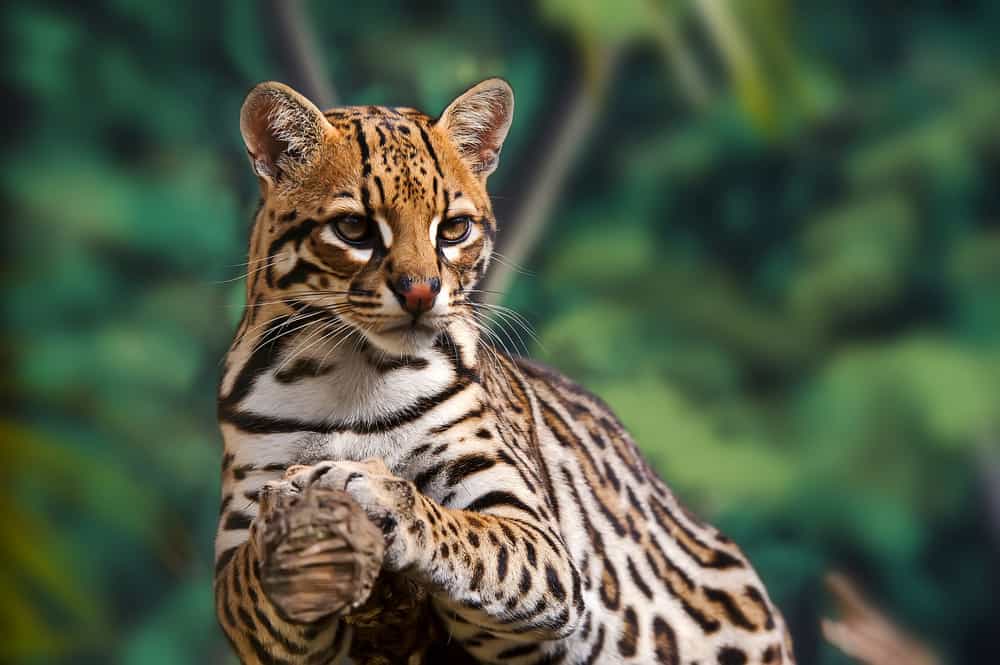
Ocelots
Ocelots, small to medium-sized wild cats native to the Americas, are known to prey on a variety of animals, including howler monkeys. Although not their primary prey, ocelots can opportunistically target howler monkeys when the opportunity arises. Their agility, keen senses, and climbing abilities make them capable hunters in the dense forest environments where both species reside.
Ocelots are skilled climbers, allowing them to navigate the treetops where howler monkeys spend much of their time. They are nimble and adept at stalking their prey from above. When an ocelot spots a howler monkey, it will patiently observe and wait for the ideal moment to pounce. With a swift and precise leap, the ocelot will seize the monkey and attempt to deliver a fatal bite, often targeting the neck or head.
While ocelots primarily rely on small mammals like rodents and birds for sustenance, they are opportunistic hunters and will take advantage of larger prey if the opportunity arises. Howler monkeys, with their size and relative abundance, can become targets of ocelots, particularly when the monkeys are young, weak, or otherwise vulnerable. However, it’s important to note that such predation events are not frequent, as howler monkeys possess strong social structures, vocal warnings, and excellent agility, which can help them evade or deter ocelot attacks.
How Howler Monkeys Adapt
Predation is a significant threat to howler monkeys, and they have developed various strategies to cope with it. Predators of howler monkeys include jaguars, ocelots, harpy eagles, boa constrictors, and anacondas. These predators are known for their stealthy movements and powerful attacks that can easily overpower their prey.
To avoid predation, howler monkeys exhibit several behaviors such as living in large groups or troops ranging from 6-18 individuals on average. This strategy provides safety in numbers; the more members there are in the group, the harder it will be for predators to single out an individual monkey.
Additionally, these primates tend to sleep high up in trees where potential threats may not reach them quickly. Moreover, when moving through the forest canopy searching for food resources or water sources, howlers communicate by loud vocalizations which alert others about any nearby danger.
Howler monkeys’ social structure helps protect themselves against predators. Living together allows them to better defend themselves. They also sleep higher up in trees to keep away from ground-based predators. Their communication system alerts other troop members of any potential harm. The collective behavior ensures that they remain safe while carrying out daily activities.
Overall, coping with predation requires adaptation from animals like howler monkeys who face constant risks from natural predators. By utilizing social structures and communication methods effectively during everyday life activities such as sleeping and feeding time periods within their habitats – these primates maximize survival chances even under dangerous circumstances.
Implications For Conservation And Management
Challenges faced in the conservation and management of howler monkeys include their vulnerability to hunting, deforestation, and habitat fragmentation.
While predators are not necessarily a primary threat, they play an important role in regulating populations and maintaining healthy ecosystems.
As such, efforts to conserve these primates must also consider factors that could impact predator-prey dynamics.
Mitigation strategies may involve implementing policies to regulate hunting practices or protect forested areas from further degradation.
Additionally, promoting ecotourism initiatives can provide economic incentives for local communities to value the preservation of natural habitats where howlers reside.
Such approaches should be tailored based on regional context, as social-cultural attitudes towards wildlife can differ greatly across different parts of the world.
Ultimately, successful conservation outcomes will require collaboration between researchers, government agencies, NGOs, and local stakeholders to develop holistic management plans that balance ecological sustainability with human well-being.
Conclusion
Predation is a natural and essential component of ecosystems, shaping the behavior and evolution of species.
Howler monkeys are no exception, facing a range of predators in their habitats across Central and South America.
While jaguars are the most formidable predator of howler monkeys, birds of prey also pose significant threats from above.
To cope with predation pressure, howler monkeys have developed various adaptations such as alarm calls and group living strategies.
Understanding the dynamics between howler monkeys and their predators can inform conservation efforts aimed at protecting these iconic primates and preserving the integrity of tropical rainforest ecosystems.
In conclusion, while predation may seem like a harsh reality for howler monkeys, it is an integral part of maintaining biodiversity in their forest homes.
By studying these interactions between predator and prey, we gain valuable insights into the delicate balance that exists within ecosystems.
It is crucial to continue to study and monitor these relationships to better manage conservation initiatives for not only howler monkeys but other threatened species as well.

